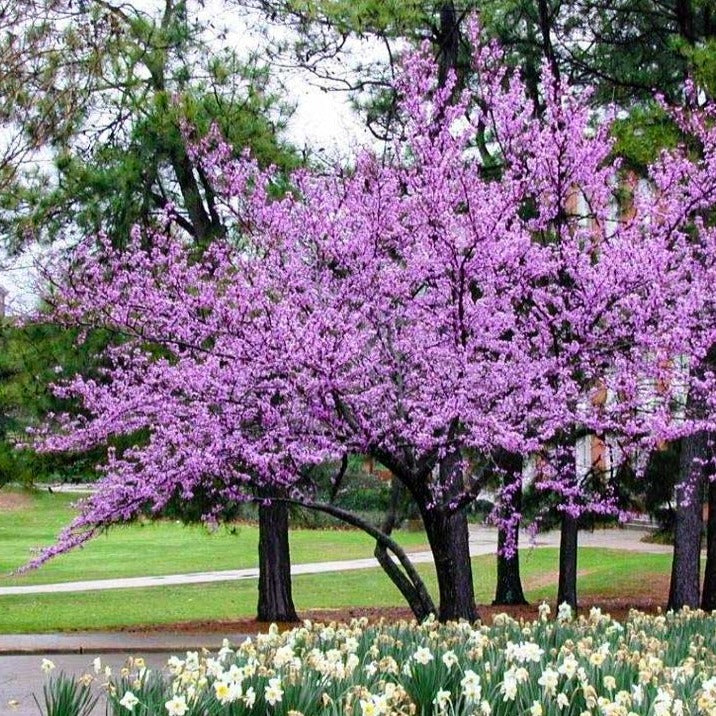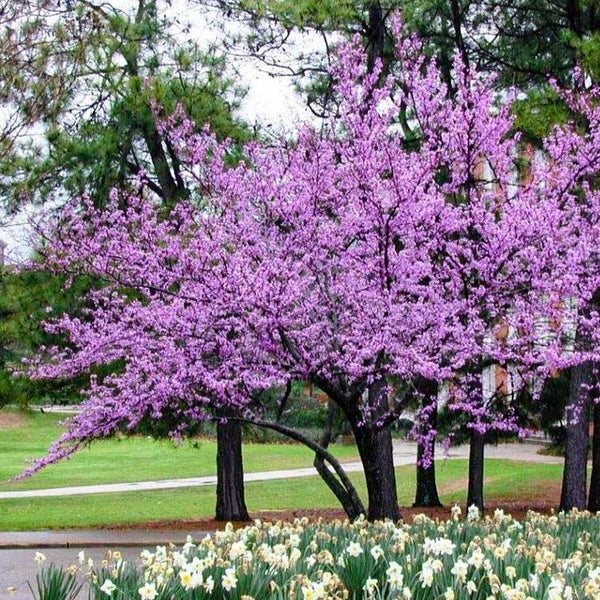Different Types of Redbud Trees: Forest Pansy, Rising Sun & More
Different types of Redbud trees include Forest Pansy, Rising Sun, and Eastern Redbud. Each variety offers unique colors and growth characteristics.
Redbud trees are popular ornamental trees known for their vibrant spring blooms and heart-shaped leaves. Forest Pansy Redbud displays deep purple foliage, adding rich color to gardens. Rising Sun Redbud features golden-yellow leaves that turn lime-green, providing a striking contrast.
Eastern Redbud, native to North America, boasts rosy-pink flowers that bloom before the leaves emerge. These trees thrive in various soil types and are relatively low-maintenance. They attract pollinators and enhance landscape aesthetics. Redbud trees are excellent choices for homeowners and landscapers seeking beauty and diversity in their planting schemes.
Introduction To Redbud Trees
The Redbud Tree is a favorite among gardeners and landscapers. Known for its stunning pink or purple flowers, it brings color to any garden. These trees are easy to grow and maintain. Redbuds thrive in various climates and soil types.
Redbud trees are not only beautiful but also versatile. They fit well in both small and large gardens. Let’s explore the different types of Redbud trees and their importance in landscaping.
Overview Of Redbud Varieties
| Variety | Description |
|---|---|
| Forest Pansy | Known for its purple leaves and vibrant flowers. |
| Rising Sun | Features golden-yellow leaves and stunning blooms. |
| Eastern Redbud | The most common type, with heart-shaped leaves. |
| Texas Redbud | Adaptable to hot climates and has thicker leaves. |
Importance In Landscaping
Redbud trees play a significant role in landscaping. Their vibrant colors add beauty to any landscape. They work well as focal points in gardens. These trees also provide shade and improve air quality.
- Aesthetic Appeal: The colorful flowers attract attention.
- Versatility: Suitable for various garden sizes.
- Low Maintenance: Easy to grow and care for.
- Environmental Benefits: Improve air quality and provide shade.
Planting a Redbud tree can transform your garden. Their beauty and benefits make them a great choice for any landscape.

Credit: www.reddit.com
Forest Pansy Redbud
The Forest Pansy Redbud is a beautiful tree known for its stunning foliage. This type of Redbud tree is popular due to its vibrant, heart-shaped leaves.
Characteristics And Growth
The Forest Pansy Redbud has unique characteristics. Its leaves change color with the seasons. In spring, the leaves are purple. During summer, they turn burgundy. In fall, the leaves become a mix of yellow and orange.
This tree can grow up to 20-30 feet tall. Its spread is about 25-35 feet. The Forest Pansy Redbud has a rounded shape. It grows fast and is easy to maintain.
| Characteristic | Description |
|---|---|
| Height | 20-30 feet |
| Spread | 25-35 feet |
| Leaf Color | Purple (Spring), Burgundy (Summer), Yellow/Orange (Fall) |
| Shape | Rounded |
Ideal Growing Conditions
The Forest Pansy Redbud thrives in well-drained soil. It prefers full sun to partial shade. This tree is hardy in USDA zones 5-9. It needs moderate watering, especially in dry periods.
Plant it in a spot with good air circulation. This helps prevent diseases. Mulch around the base to retain moisture. Avoid overwatering to prevent root rot.
- Soil: Well-drained
- Light: Full sun to partial shade
- USDA Zones: 5-9
- Water: Moderate
Rising Sun Redbud
The Rising Sun Redbud is a stunning tree known for its vibrant colors. It stands out with its heart-shaped leaves and beautiful blooms. This tree is perfect for adding a splash of color to any garden.
Unique Features
The Rising Sun Redbud has many unique features that make it special.
- Vibrant Colors: The leaves change from golden orange to bright green.
- Heart-Shaped Leaves: The leaves are heart-shaped and eye-catching.
- Compact Size: It grows to about 12 feet tall, making it ideal for small spaces.
Care And Maintenance
Caring for a Rising Sun Redbud is simple if you follow these steps.
- Watering: Water the tree regularly, especially during dry spells.
- Soil: Plant in well-drained soil for best results.
- Sunlight: Ensure the tree gets full to partial sunlight.
- Pruning: Prune in early spring to shape the tree and remove dead branches.
- Fertilizing: Use a balanced fertilizer in the growing season.
| Feature | Detail |
|---|---|
| Height | 12 feet |
| Sunlight | Full to Partial Sun |
| Water Needs | Regular Watering |
| Soil Type | Well-Drained |
Eastern Redbud
The Eastern Redbud (Cercis canadensis) is a captivating tree known for its vibrant pink flowers. This tree adds a pop of color to any landscape. It is a favorite among gardeners and landscapers.
Native Habitat
The Eastern Redbud is native to eastern North America. It thrives in USDA hardiness zones 4 to 9. You can find it in woodlands and along streams. It prefers well-drained soil but can adapt to different soil types.
Common Uses
The Eastern Redbud is popular in landscaping. Its vibrant flowers make it a perfect ornamental tree. People also use it for shade and privacy in gardens.
- Ornamental tree
- Shade provider
- Privacy screen
| Feature | Description |
|---|---|
| Flower Color | Pink |
| Height | 20-30 feet |
| Width | 25-35 feet |
| Soil Preference | Well-drained |
Planting an Eastern Redbud can enhance your garden’s beauty. It is easy to care for and offers stunning spring blooms.
Texas Redbud
The Texas Redbud is a stunning tree known for its striking, rosy-pink flowers. This tree adds a burst of color to any landscape. It’s especially popular in regions with hot, dry climates.
Drought Tolerance
The Texas Redbud stands out for its excellent drought tolerance. This tree can thrive with minimal water. It’s perfect for areas with limited rainfall.
Once established, the Texas Redbud needs little supplemental watering. This makes it a low-maintenance option for gardeners.
Planting Tips
Here are some essential planting tips for the Texas Redbud:
- Soil: Plant in well-drained soil for best results.
- Sunlight: Ensure it receives full sun to partial shade.
- Spacing: Space trees about 15-20 feet apart.
Follow these tips to ensure your Texas Redbud thrives:
- Dig a hole twice as wide as the root ball.
- Place the tree in the hole at the same depth it was in the pot.
- Backfill with soil and water thoroughly.
Water regularly during the first growing season. This helps establish a strong root system. Mulch around the base to retain moisture and suppress weeds.
| Aspect | Details |
|---|---|
| Soil | Well-drained |
| Sunlight | Full sun to partial shade |
| Spacing | 15-20 feet apart |
Mexican Redbud
The Mexican Redbud is a stunning variety of the Redbud tree. It brings vibrant colors to any garden. Native to Texas and Mexico, this tree thrives in warmer climates. Its beautiful leaves and flowers add charm and appeal to landscapes.
Leaf And Flower Traits
The Mexican Redbud has unique leaf and flower traits. Its leaves are smaller than other Redbud varieties, typically heart-shaped. They are glossy and dark green in summer, turning golden yellow in fall. The flowers are bright pink to purple, appearing in early spring. These blooms attract bees and butterflies, adding life to your garden.
Soil Preferences
The Mexican Redbud prefers well-drained soil. Sandy or loamy soils are ideal. It can tolerate dry conditions once established. Avoid heavy clay soils which retain too much water. Ensure the planting site has good air circulation.
Here’s a quick guide to the soil preferences of the Mexican Redbud:
| Soil Type | Preference |
|---|---|
| Sandy Soil | High |
| Loamy Soil | High |
| Clay Soil | Low |
For the best growth, keep the soil slightly moist. Water young trees regularly. Mature trees need less frequent watering. Mulch around the base to retain moisture and reduce weeds.
Choosing The Right Redbud
Redbud trees bring vibrant color and unique beauty to any landscape. With varieties like the Forest Pansy and Rising Sun, there’s a redbud tree for every garden. But how do you choose the right one for your yard? Consider several factors to make the best choice.
Factors To Consider
When choosing a redbud tree, you need to think about several key factors. Each variety has unique features and requirements. Understanding these will help you make the best decision.
- Size: Some redbuds grow taller than others. Make sure your space can accommodate the tree’s mature size.
- Leaf Color: Different varieties offer various leaf colors. Choose one that complements your garden’s color scheme.
- Growth Rate: Some redbuds grow faster than others. Decide if you want quick shade or a slower-growing specimen.
- Maintenance: Consider how much care each variety needs. Some may require more pruning and upkeep.
Climate Compatibility
Your local climate plays a crucial role in the health of your redbud tree. Different types thrive in different conditions. Knowing your region’s climate helps you choose the right redbud.
| Redbud Variety | USDA Hardiness Zones | Climate Preferences |
|---|---|---|
| Forest Pansy | 5-9 | Prefers full sun to partial shade |
| Rising Sun | 5-9 | Thrives in full sun |
| Texas Redbud | 6-9 | Adapts well to hot climates |
Make sure your chosen redbud matches your area’s weather patterns. This ensures a healthy and thriving tree for years to come.

Credit: www.plantingtree.com

Credit: www.plantingtree.com
Frequently Asked Questions
What Are The Different Types Of Redbud Trees?
There are several types of redbud trees. Popular varieties include Eastern Redbud, Forest Pansy, Texas Redbud, and Mexican Redbud. Each has unique features and growth habits.
What Is The Difference Between Forest Pansy Redbud And Redbud?
The Forest Pansy Redbud features vibrant purple leaves, while the standard Redbud has green leaves. Both bloom pink flowers.
Which Is The Prettiest Redbud Tree?
The Eastern Redbud is often considered the prettiest redbud tree. It features stunning pink-purple flowers in early spring.
Where Is The Best Place To Plant Forest Pansy Redbud?
Plant Forest Pansy Redbud in well-drained soil with full sun to partial shade. Ensure protection from strong winds.
Conclusion
Redbud trees offer beauty and variety to any landscape. Forest Pansy and Rising Sun are popular choices. Each type has unique features, enhancing your garden’s appeal. Choose the right redbud tree to enjoy vibrant colors and seasonal interest. Embrace the charm of these lovely trees in your outdoor space.

